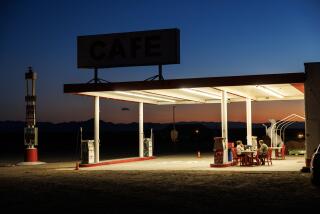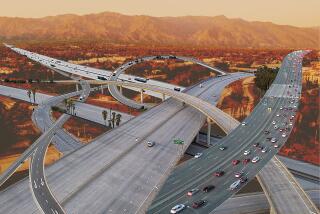American Nomad
“There are times when one just feels like driving,” wrote 32-year-old Texan Larry McMurtry amid the social upheaval of 1968. He said that in “A Look at the Lost Frontier,” an account of a car trek around his robust home state in “In A Narrow Grave,” his elegant collection of loosely connected essays published 32 years ago by the tiny Encino Press in Austin. With that book, McMurtry, who had been deflating Lone Star myths in graceful fiction and thoughtful nonfiction throughout the 1960s, joined the stream of American literary luminaries who have set out on the open road since Theodore Dreiser wrote the first literary autologue, “A Hoosier Holiday,” in 1916.
It’s no coincidence that McMurtry dedicated “In A Narrow Grave” to his friend Ken Kesey, a classmate at Stanford University’s creative writing program in NOMAD Continued from Page 1 1960. McMurtry, who attended on a Wallace Stegner Fellowship, was deemed the most gifted of the students by teacher Malcolm Cowley, and the next year--two years before Kesey published “One Flew Over the Cuckoo’s Nest”--McMurtry’s first novel, “Horseman, Pass By,” debuted to great acclaim and was made into the hit movie “Hud” starring Paul Newman. While the so-called New Journalists were celebrating Kesey as the psychedelic avatar of the counter-culture whose trips across America on the Merry Pranksters’ bus were blazing trails into the future, McMurtry understood that his intrepid friend was actually a throwback to the range rovers of old, indeed “the last wagon-master.” For McMurtry could see that by 1968 the lonesome old two-lane roads of escape across the nation, its fabled Route 66s and Highway 61s, were losing favor to the 42,000 miles of high-speed freeways of President Eisenhower’s inspired U.S. Interstate Highway system--and that answering the call of the open road would never be the same. McMurtry knew there was more of the Old West in Kesey’s spirited unsettling of America than there was of the avant-garde.
Of course, as McMurtry wrote of exploring the New West in “In a Narrow Grave,” “One sometimes wonders if Bowie and Travis and the rest would have fought so hard for this if they had known how many ugly motels and shopping centers would eventually stand on it.” But as his marvelous new book, “Roads,” shows, McMurtry has learned to accept, if somewhat begrudgingly and with wry humor, the Wal-martization of America. Unlike William Least Heat-Moon in 1982’s “Blue Highways,” a Whitman-esque paean to the nation’s vanishing back lanes, McMurtry refuses to disparage the Pizza Huts and K-Marts and 7-Elevens that dot the strip malls and dysfunction junctions that span today’s United States. Instead, he expresses delight that Hope, Ark., has a Sizzler; that Duluth, Minn., has a revolving restaurant; and that he has stayed in more than 200 Holiday Inns. “Roads” is, in fact, a coyly upbeat celebration of the great East-to-West super-slabs, Interstates 10, 40 and 70, and the usually trustworthy 5, 25, 33 and 75 running north to south.
To McMurtry, the Interstates are true freeways--quick escape routes not from a Soviet nuclear missile attack, as Eisenhower had in mind when he ordered their construction in 1956, but from the parochialism of Main Street America that Sinclair Lewis and Sherwood Anderson wrote about. Like playwright Sam Shepard, who sees the spreading fast-food franchised sameness and suburban asphalt sprawl as “magical, mystical junk,” the even less elitist McMurtry recognizes that the ubiquitous glowing golden arches and Big Gulp signs are, as Tom Wolfe put it, “the new landmarks Douglas Brinkley is director of the Eisenhower Center for American Studies and professor of history at the University of New Orleans. His most recent book is “Rosa Parks.” of America, the new guideposts, the new way Americans get their bearings.”
As McMurtry explains at the outset of “Roads” while driving the mundane leg of Interstate 35 from Dallas to San Antonio, “[t]he repetitiveness of that particular stretch of highway, with the same business clustered at almost every exit, tempts me to advance one modest thesis, a counter-argument to the often expressed view that because of the chain businesses, America all looks the same. But it doesn’t, and it won’t, no matter how many McDonald’s and Taco Bells cluster around the exits. There are, after all, McDonald’s in both Moscow and Paris, but few would argue that Russia and France look the same. In America the light itself will always differ: the winter light on the Sault Ste. Marie, at the head of the 75, will never be like the light over the Everglades, at the bottom of that road. Eastern light is never as strong or as full as western light; a thousand McDonald’s will not make Boston feel like Tucson. Cities and suburbs and freeway exits may collect the ugliness of consumer culture, but place itself cannot be homogenized.” And it’s the trivia McMurtry tells about distinct places like St. Paul and Jacksonville and La Crosse that make his new book such a delight.
“Roads” follows the tradition of John Steinbeck’s “Travels With Charley” (1961), Erskine Caldwell’s “Around About America” (1964) and William Saroyan’s “Short Drive, Sweet Chariot” (1966), all enjoyable autobiographical travelogues by world-renowned literary lions of a certain age out to get back in touch with an American landscape they had lost track of. Like these distinguished forebears, McMurtry, 64, turns his Buick--the same make Saroyan favored--into a vehicle for reflection. “I wanted to drive the American roads at the century’s end,” the author explains, “to look at the country again, from border to border and beach to beach.” But though Steinbeck, Caldwell and Saroyan meandered the lower 48 states hoping to soak up their culture one last time, McMurtry spent much of 1999 racing around like Jack Kerouac and Neal Cassady in the frenetic “On the Road,” priding himself on logging 800 to 1,000 miles a day. “Like most long distance drivers I usually gamble on being able to get away with ten miles over the speed limit,” he admits. “Thus fifty-five means sixty-five, and the seventy that now prevails means eighty.” And it’s this telltale exuberance in a fresh-minted member of what actor Jack Nicholson calls “The New Old” that gives the lie to Hunter S. Thompson’s quip in “Fear and Loathing in Las Vegas” (1972), that “Old elephants limp off to the hills to die; old Americans go out to the highway and drive themselves to death with huge cars.”
Thus there is something exquisitely life-affirming about “Roads,” beginning with McMurtry’s candid admission that despite his struggles with serious bouts of depression, his has been a mostly “happy life,” dominated by three passions: books, women and the road. So, “[a]s age approaches,” he reasoned, “the appetite for long drives may leave me, which is why I want to get rolling now.” The result gives “Roads” its philosophical transcendentalist quality, with McMurtry as Thoreau on six cylinders at $1.58 a gallon. Unlike most travel books, this one makes the route the author’s destination, driving his therapy and means of relaxation. Ralph Waldo Emerson once put it, “There is no truth but in transit,” and McMurtry bears him out. “Roads” is not just about interstate attractions and gas pumps off the exits; it’s a meditation on growing old in America and a sharing of the wisdom McMurtry has gleaned from his years as a cattle rancher, first-rate novelist, English professor, Hollywood screenplay writer and Washington, D.C. rare book dealer. For through all those careers there remained a nagging wanderlust in McMurtry’s soul, and “Roads” can be read as his means of purging it by driving so far that eventually he just wanted to go home and stay for at least a little while. McMurtry says he is content now to live back in his boyhood town of Archer City, Texas, where he operates a massive used book emporium.
That love of books is apparent throughout this new work, as McMurtry--whose own library includes 3,000 travel volumes--discusses his favorites in the Western tradition, which can be traced at least back to the Icelandic and Norwegian epic narratives of the 13th century. His crisp commentaries on Eric Newby’s “Slowly Down the Ganges,” Wilfred Thesiger’s “Arabian Sands” and Teddy Blue’s “We Pointed Them North,” among many others, add a worthy scholarly bonus to the text. What’s more, while racing through the United States, McMurtry was often brought to ponder “largely forgotten books” by treasured obscured authors from the regions he visits: O.E. Rolvaag in Minnesota, Walter Havighurst in Missouri, Theodore Roethke in Washington. Such erudition downing doughnuts and orange juice at a Quick Stop on Interstate 90 affords “Roads” a disarming lack of pretense.
What make McMurtry’s new book as much a credit to its genre as “Travels With Charley,” however, are its author’s sharp eye and fine prose, whether he’s describing Cajun cooking, Kansas street fights, Idaho skinheads, Century City parking, Key West flora, Brazos Valley sunsets, Georgetown grandees or Montana skies. Some of the best writing comes when McMurtry turns acerbic, as he does regarding urban sprawl and the “Culture of Congestion” manifest in such unlovely population centers as Oklahoma City, North Carolina’s Research Triangle and any Eastern seaboard city along Interstate 95, a route he loathes too much to write about. In many cases, his objections are not so much to places as to the people in them, as he writes of driving through central Tennessee: “The happiest surprise, along the route, was the discovery of a nice new bypass around Nashville, a mean town that I usually race through with my head down, hoping not to be shot, broadsided, or otherwise slowed. . . . Though a large, sophisticated city now, Nashville still seems to me to be dominated by the suspicious us-and-them psychology of the mountain hollows; Appalachian passivity alternates unpredictably with Appalachian ferocity.”
Thus it’s not surprising--indeed it’s refreshing--that Los Angeles is McMurtry’s Mecca and its freeways his Ganges. Although he takes a few of the usual swipes at movie studio executives, valet parking and the Pomona Freeway, McMurtry grasps the complex essence of Los Angeles beyond the “ego zoo” of Hollywood, seeing the City of Angels as the last American promised land, a warped but still magical place that can lure hordes, people hopeful enough to try to remake their thwarted lives. “Jack Kerouac said long ago that L.A. was the West Coast’s one and only golden town, and he was right,” McMurtry explains in “Roads.” “I still got a lift from going there, still enjoy its confusion, its color, its brassiness.”
So it’s little wonder that McMurtry includes a section from Kerouac’s “On the Road”--the sentimental “Mexican Girl”--in his new edited collection “Still Wild: Short Fiction of the American West, 1950 to the Present.” Consisting of 20 stories that represent, in various ways, the “coming of age” of the American frontier, “Still Wild” offers such fine works as Wallace Stegner’s haunting “Buglesong,” William Gass’ flawless “The Pedersen Kid” and Annie Proulx’s unforgettable “Brokeback Mountain.”
From Dave Hickey’s “The Closed Season,” which begins with a dream of cruising lower Main Street in South Fort Worth, Texas; to Richard Ford’s “Rock Springs,” with its opening line about fleeing Montana for Florida by automobile; to Max Apple’s “Gas Stations,” an ode to the world’s biggest truck stop in Oasis, Wyo., “Still Wild’s” stories for the most part share the theme of rootlessness and escape by highway, mobility, displacement and the drifting they engender. The hero of Louise Erdrich’s “The Red Convertible” is an Oldsmobile, rendered as a freedom machine of almost holy powers in Kerouac-like prose: “[I]t was down through Spokane and across Idaho then Montana and very soon we were racing the weather right along under the Canadian border through Columbus, Des Lacs and then we were in Bottineau County and soon home.” The same high-speed effect marks Diana Ossana’s randy “White Line Fever” as the story passes through Amarillo’s Maverick Motel, Dubuque’s Devry Over-The-Road Trucking School and the Guadalajara Cafe in Clovis, N.M. in a Volkswagen van blaring Merle Haggard’s “Greatest Hits” on cassette.
“Still Wild” is--happily--exactly the Western short story collection one would expect with McMurtry as editor. After all, his comic novel “Cadillac Jack” (1982) concerns an ex-rodeo bulldogger taken to crisscrossing the nation in a pearl-colored Cadillac to trade antiques; his Pulitzer Prize-winning 1985 epic “Lonesome Dove” centers on a hard-knocks cattle drive from Texas to Montana, and the author’s alter ego Danny Deck, the memorable protagonist of “Moving On” (1970) and “All My Friends Are Going To Be Strangers” (1972), is as restless and rootless a character as any in recent American fiction.
Put simply, for Larry McMurtry--as for most of the writers in “Still Wild”--movement for movement’s sake is preferable to squeaking out a meager life of quiet desperation in one place. Like a graying Huck Finn, he finds meaning in the simple act of lighting out whenever the mood strikes, for the sheer freedom to drive endlessly and pointlessly until the sensible instinct to settle down returns, even if the indulgence had pollution, congestion, fast food and strip malls. At heart, McMurtry seems proud to serve as literary spokesman for that lonely and romantic tribe of American nomads who can’t help but find the prettiest sight of the town just left behind in the lights reflected in a rear view mirror.
More to Read
Sign up for our Book Club newsletter
Get the latest news, events and more from the Los Angeles Times Book Club, and help us get L.A. reading and talking.
You may occasionally receive promotional content from the Los Angeles Times.







